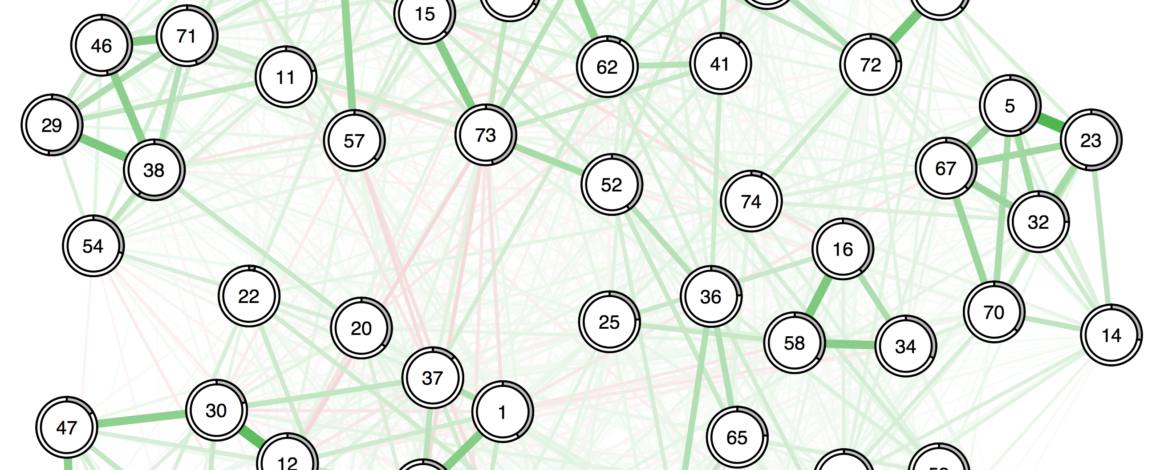APS 2017 in Boston just ended, with plenty of insightful talks about new developments in network methodology and application of network analysis to substantive topics.
For those of you who couldn’t be there, I wanted to provide a summary of the topics that were discussed, and upload all presentations I could gather. If there were other presentations I missed, please send me an email and I will update the collection below.

Clinical applications
Comorbidity of depression and OCD
Payton Jones from Harvard University gave a talk about network analysis in a dataset of adolescent patients with depression and OCD (preprint; slides), and Claudia van Borkulo from the University of Amsterdam presented on predicting OCD remitters vs persisters using network analysis, modeling both depression and OCD symptoms (slides).
Personalized complicated grief networks
Don Robinaugh from Harvard University gave a presentation on time-series network analysis of patients with complicated grief, and presented 2 example networks. This is an ongoing study that looks into similarities and differences of complicated grief networks across people (slides).
Idiographic analyses of patients with depression and anxiety
Aaron Fisher from UC Berkeley presented some new results of his idiographic study that assesses networks of patients before treatment and uses insights gained from these networks to select specific treatment modules. Aaron blogged about this study here, and you can also find the dataset for re-analysis in his blog post. His presentation is available here.
Hysteresis
Claudia van Borkulo from the University of Amsterdam also gave a talk about a paper on hysteresis that was published by Angelique Cramer et al. in Plos One recently. The paper tackles the issue that networks with stronger connections may be more vulnerable to phase transitions, and that such networks may not return to healthy states even if the external stressor that triggered the transition is removed (a phenomenon called hysteresis). The slides are available here.
Neuroimaging: the dynamics of cognitive flexibility in the human brain
John Medaglia from University of Pennsylvania gave a presentation on the “The Dynamics of Cognitive Flexibility in the Human Brain” (slides).
A network perspective on social anxiety disorder
Alexandre Heeren from Harvard University gave insights into a new study on symptom-to-symptom associations in social anxiety disorder, which result in a densely connected network structure (slides).
Replicability of PTSD networks
I presented our research on fitting cross-sectional network models on 4 different large samples of traumatized patients to investigate the replicability and generalizability of PTSD networks (blog, paper, slides).
Methodological developments
Estimating intraindividual networks using autoregressive models
Noémi Schuurman from Utrecht University provided an introduction to intraindividual network models, and showed some of the features Mplus 8 brings with it that are hard to tackle in R currently (such as correlated residuals). She also talked about two pitfalls: measurement error and standardization, which also feature prominently in her work (e.g. here or here). You can find Noémi’s presentation here.
Inferring Causal Networks from Experimental Data
Jolanda Kossakowsi from the University of Amsterdam gave a talk about the caveats of trying to infer causal networks from observational data, and presented her project in which she asks people the same set of attitudes multiple times in a row, each time “intervening” on one of the items (“imagine you would not like meat, how guilty would you feel if you ate meat”). This highly interesting innovation may allow for easier causal inferences (slides).
Predicability and controllability of network models
Jonas Haslbeck from the University of Amsterdam presented his work on predictability, an absolute metric that quantifies how much influence one can have on a node in the network via its neighbors. Jonas blogged about predictability here, and he wrote two papers about it: one technical paper which explains the metric in more detail, and one application paper in which we re-analyzed 25 network analysis datasets from 18 published papers to see how predictability looks like in the field so far. His slides are available here.
Assessing the risk for the development of critical transitions in psychopathology
Jolanda Kossakowsi also talked about critical phase transitions in psychopathology research where patients move from healthy to e.g. depressed network states, and presented new models that may enable us to detect such transitions (slides).
A tutorial on regularized partial correlation networks
I presented a brief introduction to the strengths, limitations, and future directions of regularized partial correlation networks in cross-sectional data, along with a tutorial on how to estimate these models in R under revision in Psychological Methods (tutorial paper, slides).
Thanks to everyone who made my APS 2017 such a fantastic experience, and a big shoutout to all presenters who shared their slides with me so I could make them publicly available! If you would like to reuse the slides, please contact the authors and also make sure to acknowledge them for their contributions.
